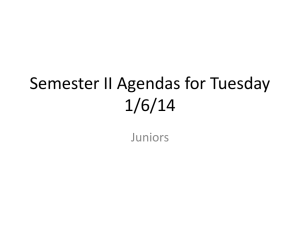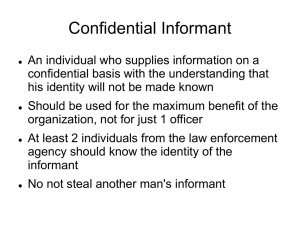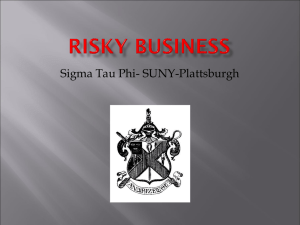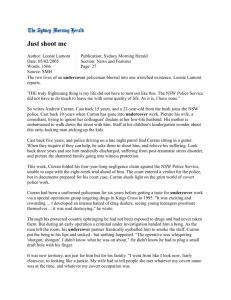Exploring the practice of undercover selling
advertisement
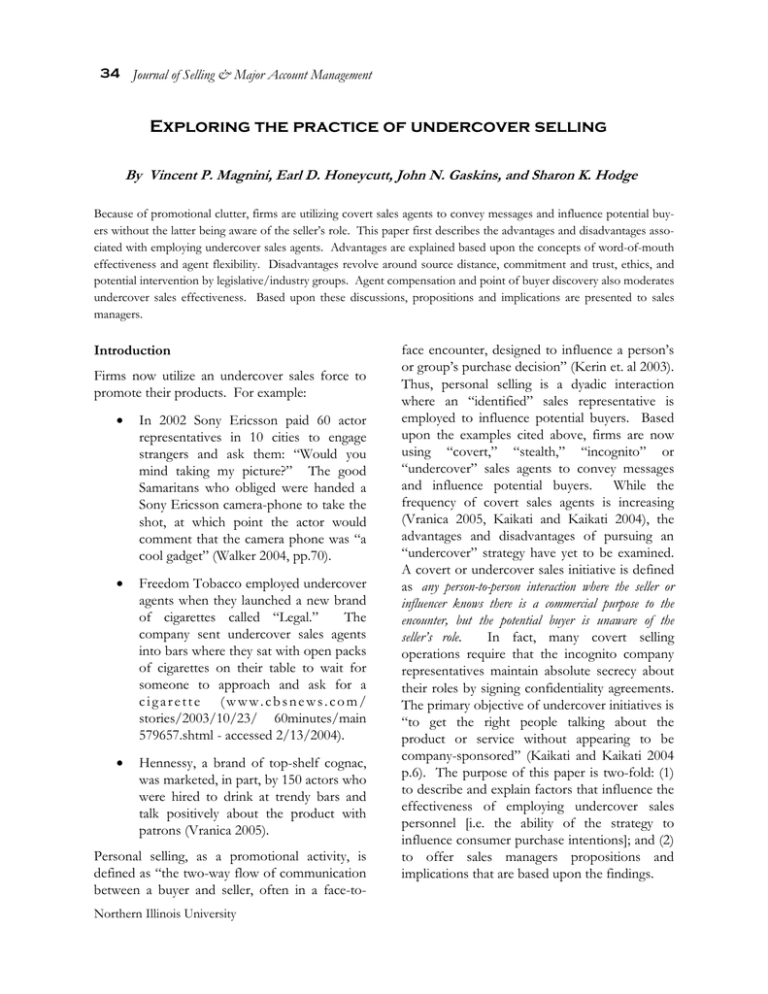
34 Journal of Selling & Major Account Management Exploring the practice of undercover selling By Vincent P. Magnini, Earl D. Honeycutt, John N. Gaskins, and Sharon K. Hodge Because of promotional clutter, firms are utilizing covert sales agents to convey messages and influence potential buyers without the latter being aware of the seller’s role. This paper first describes the advantages and disadvantages associated with employing undercover sales agents. Advantages are explained based upon the concepts of word-of-mouth effectiveness and agent flexibility. Disadvantages revolve around source distance, commitment and trust, ethics, and potential intervention by legislative/industry groups. Agent compensation and point of buyer discovery also moderates undercover sales effectiveness. Based upon these discussions, propositions and implications are presented to sales managers. Introduction Firms now utilize an undercover sales force to promote their products. For example: • In 2002 Sony Ericsson paid 60 actor representatives in 10 cities to engage strangers and ask them: “Would you mind taking my picture?” The good Samaritans who obliged were handed a Sony Ericsson camera-phone to take the shot, at which point the actor would comment that the camera phone was “a cool gadget” (Walker 2004, pp.70). • Freedom Tobacco employed undercover agents when they launched a new brand of cigarettes called “Legal.” The company sent undercover sales agents into bars where they sat with open packs of cigarettes on their table to wait for someone to approach and ask for a cigarette (www.cbsnews.com/ stories/2003/10/23/ 60minutes/main 579657.shtml - accessed 2/13/2004). • Hennessy, a brand of top-shelf cognac, was marketed, in part, by 150 actors who were hired to drink at trendy bars and talk positively about the product with patrons (Vranica 2005). Personal selling, as a promotional activity, is defined as “the two-way flow of communication between a buyer and seller, often in a face-toNorthern Illinois University face encounter, designed to influence a person’s or group’s purchase decision” (Kerin et. al 2003). Thus, personal selling is a dyadic interaction where an “identified” sales representative is employed to influence potential buyers. Based upon the examples cited above, firms are now using “covert,” “stealth,” “incognito” or “undercover” sales agents to convey messages and influence potential buyers. While the frequency of covert sales agents is increasing (Vranica 2005, Kaikati and Kaikati 2004), the advantages and disadvantages of pursuing an “undercover” strategy have yet to be examined. A covert or undercover sales initiative is defined as any person-to-person interaction where the seller or influencer knows there is a commercial purpose to the encounter, but the potential buyer is unaware of the seller’s role. In fact, many covert selling operations require that the incognito company representatives maintain absolute secrecy about their roles by signing confidentiality agreements. The primary objective of undercover initiatives is “to get the right people talking about the product or service without appearing to be company-sponsored” (Kaikati and Kaikati 2004 p.6). The purpose of this paper is two-fold: (1) to describe and explain factors that influence the effectiveness of employing undercover sales personnel [i.e. the ability of the strategy to influence consumer purchase intentions]; and (2) to offer sales managers propositions and implications that are based upon the findings. Spring 2006 REASONS TO EMPLOY AN UNDERCOVER SALES FORCE Marketplace clutter can make undercover selling an appealing and effective marketing strategy. That is, marketers find it increasingly challenging to penetrate marketplace clutter to win consumer awareness (Pieters, Warlop, and Wedel 2002). Primetime television is 24 percent promotional content, consumer magazines are composed of 50 percent advertising, and newspapers contain as much as 64 percent advertising (Television Commercial Monitoring Report 1995; 1994/1995 Magazine Handbook 1995). The average American consumer is saturated daily with increasing numbers of promotional messages. For example, consumers were exposed to approximately 3600 sales messages per day in 1996, an increase from 1500 in 1984 (Jhally 1998). The limited cognitive capacity of a consumer can make it impossible to comprehend such large numbers of sales messages (Jacoby 1984; Malhorta 1982). Consequently, advertising overload leads consumers to develop coping mechanisms and avoidance tactics that protect them from being overwhelmed by marketing messages (Speck and Elliott 1997). Specifically, when an environment is replete with ad messages, consumers filter out excess stimuli and pay selective attention to messages that pass through an individual’s internal screening criteria (Rumbo 2002). The degree of filtering is even more pronounced when the consumer has a low level of involvement with the product category and/or purchase decision (Kahneman 1973). Furthermore, sustained over-exposure to promotional clutter triggers consumer feelings of skepticism and resentment (Goldman and Papson 1994). Therefore, by employing covert sales agents, firms are able to breach consumer avoidance tactics. This penetration is possible in an undercover scenario because the consumer is unaware that the information exchange involves a company marketing representative. Based upon this discussion the first proposition states: 35 Proposition # 1: Sales clutter in the marketplace correlates positively with the effectiveness of a firm’s undercover sales agent strategy. Personal information sources play a central role in influencing product selection (Katona and Mueller 1954; Kiel and Layton 1981; Price and Feick 1984), choosing service providers (Keaveney 1995), and diffusing information about new product offerings (Arndt 1967; Engel, Kegerreis, and Blackwell 1969; Feldman and Spencer 1965; Sheth 1971). In fact, word-ofmouth (WOM) exerts a greater influence on consumer product judgments than print information (Herr et al. 1991). For example, positive brand attitudes are formulated on the basis of a single, favorable WOM communication, even when detailed product information is also available (Mangold, Miller, and Brockway 1999). The usefulness of undercover marketing relies on the assertion that WOM remains the most effective form of promotion (Kaikati and Kaikati 2004). The significant influence of WOM on consumer decision-making is attributable to its vividness as a form of communication (Herr et al. 1991). “Vividness refers to a message that is interesting, concrete, and image provoking. Also, for a message to be considered vivid it must be proximate in a temporal, spatial, or sensory way (Nisbett and Ross 1980). A word-of-mouth message meets these criteria primarily because WOM often occurs in a face-to-face encounter. Furthermore, since WOM is a vivid form of marketing communication, it possesses an ability to attract attention, hold interest, and bolster the information’s accessibility from memory (Herr et al. 1991; Nisbett and Ross 1980). Although it can be argued that traditional forms of personal selling are vivid, undercover selling initiatives are even more so because consumers tend to mentally tune-out and/or refute formal presentations (Petty and Cacioppo 1981); whereas, undercover initiatives face less mental screening. Hence, disguising an undercover sales agent’s marketing message as WOM suggests: Vol. 6, No. 2 36 Journal of Selling & Major Account Management Proposition # 2: The degree of vividness of information in an undercover selling encounter is positively correlated with the strategy’s effectiveness. Marketers also experience increased difficulty in reaching potential buyers because cable TV, satellite TV, and satellite radio are fragmenting advertising audiences. Likewise, TV prerecording technologies (e.g. TIVO) screen advertisements out of viewer content. As a result, the number of TV commercials needed to reach 80% of 18 to 49 year old women increased from three ads in 1995 to 97 ads in 2000 (Boyle 2003). In contrast, covert sales agents can seek out and approach prospects that “fit the mold” of a potential buyer or brand advocate. Even though a covert sales agent’s reach is significantly less than other promotional media their effectiveness at reaching the targeted group, like all salespersons, appears to be higher. Moreover, since business environments continuously change, the stealth salesperson possesses the capability to react faster (and more discreetly) than those firms whose large marketing expenditures are locked into longterm promotional commitments (Ahmed 2000). In other words, an undercover sales agent can alter whom s/he approaches and which message is emphasized based upon changes in the competitive, social, or economic environment. In such circumstances, the targeting and message flexibility of undercover sales agents are greater than the pliancy afforded traditional sales agents. This is because traditional sales agents are expected to ‘fit the mold’ of the company’s culture that they represent. Conversely, undercover agents have no such mold and consequently have more freedom to act as “chameleons” in various situations since the companies that they represent are disguised. Therefore: Proposition # 3: 3a: The targeting flexibility afforded by undercover agents is positively associated Northern Illinois University with the effectiveness of an undercover sales strategy. 3b: The message flexibility afforded by undercover agents is positively associated with the effectiveness of an undercover sales strategy. Social influence exerts a powerful effect on consumers and is relevant to undercover sales strategies. A particularly relevant aspect of social influence is social proof (Cialdini 2001). The idea behind the social proof phenomenon is that one way to determine what is correct is to find out what others believe is correct. Thus, in a marketing context, consumers look to the behavior of other consumers to determine how they should act in a given purchasing situation; that is, what products—and more importantly— what brands they should buy. Individuals view behavior to be correct when they see others performing that behavior. Humans acquiesce to this type of social influence for several reasons. Some people mimic the behavior of others because they believe that such behavior will lead to social approval and acceptance rewards. At other times, people look to the behavior and decisions of others when they are uncertain how to act or respond in a particular situation. Thus, having undercover sales agents utilize the product in naturalistic settings taps directly into this social influence technique. Reliance on social proof is greater for products that have higher degrees of perceived risk and for purchases that are publicly consumed; that is, they are socially conspicuous or easily observed by others (Ford and Ellis 1980; Bearden and Etzel 1982). The power of social proof helps convince consumers that if everyone is buying it, they should be buying it too. Thus: Proposition # 4: The degree of consumer reliance on social proof for making purchasing decisions is positively related to the effectiveness of the undercover sales strategy. Spring 2006 REASONS NOT TO EMPLOY UNDERCOVER SALES FORCE AN Since word-of-mouth communication is a social behavior, WOM sources can be classified based upon the “closeness” of the relationship between the decision-maker and the source (Brown and Reingen 1987). This closeness is termed “tie strength” and is considered stronger when the information source and the decisionmaker have a personal relationship. Conversely, weaker tie strength exists when a WOM source is an acquaintance or a stranger (Duhan et al. 1997). People in a stronger tie relationship interact more frequently and exchange larger amounts of information than those in a weaker tie dyadic relationship (Brown and Reingen 1987; Reingen and Kernan 1986). A circumstance in which a consumer interacts with an undercover sales agent qualifies as a weaker tie WOM scenario because the sales agent is only an acquaintance. This weaker tie situation is less likely to activate a high level of information transfer than an encounter in which the two parties forge a stronger tie relationship (Brown and Reingen 1987; Granovetter 1973; Leonard-Barton 1985; Reingen and Kernan 1986). More specifically, individuals in a stronger tie relationship know more about each other, including how relevant they are to one another as sources of information about a specific product (Brown and Reingen 1987). As a result: Proposition # 5: An undercover sales agent is a weak-tie source and correlates negatively with sales effectiveness. In the marketing literature trust is defined as “a willingness to rely on an exchange partner in whom one has confidence” (Moorman, Deshpande, and Zaltman 1993, p. 82). Similarly, Morgan and Hunt (1994) describe trust as: “when one party has confidence in an exchange partner’s reliability and integrity” (p. 23). Both definitions emphasize confidence. Confidence on behalf of the trusting party is built through 37 consistent, competent, honest, fair, responsible, helpful, and benevolent behaviors exhibited by the trustworthy party (Altman 1973; Dwyer and LaGace 1986; Larzelere and Huston 1980; Rotter 1967). One may ask what happens when unsuspecting consumers are approached by undercover sales associates who possess a hidden agenda? The likely outcome is a negative impact on confidence and an erosion of trust. For example, according to the Wall Street Journal, the Sony Ericsson incognito tactic discussed in this article’s introduction received wide criticism (Vranica 2005). The outcome of eroding trust is typically a reduction in buyer commitment. Because commitment entails vulnerability, constituents search for trustworthy parties (Morgan and Hunt 1994). Consequently, since trusting relationships are held in high regard, parties strive to commit themselves to such relationships (Hrebiniak 1974; Morgan and Hunt 1994). Theoretical anchoring for this logic is found in social exchange theory that posits that “mistrust breeds mistrust and as such would also serve to decrease commitment in the relationship” (McDonald 1981, p. 834). Hence, if an individual discovers that s/he was targeted by an undercover sales agent; or that s/he is conducting business with a company known for engaging in such tactics; decreased consumer trust, and ultimately reduced commitment may result. In accordance with these discussions the next proposition states: Proposition # 6: The erosion of commitment and trust spawned by undercover selling is negatively associated with the strategy’s effectiveness. Over the past three decades heightened theoretical and empirical attention has been directed at the ethical dimensions of sales practices (c.f. Bellizzi and Hite 1989; Chonko and Burnett 1983; Levy and Dubinsky 1983; McIntyre, Thomas, and Gilbert 1999; Wotruba 1990). In recent years sales managers across a broad spectrum of industries advised their reps Vol. 6, No. 2 38 Journal of Selling & Major Account Management to address issues of ethics and corporate responsibility (Gilbert 2003). From an ethical perspective, consumers expect “fairness and honesty” from a firm’s sales representatives (McIntyre, Thomas, Gilbert 1999, pp. 43). Since “withholding information” violates an expectation of honesty (McIntyre, Thomas, Gilbert 1999, pp. 46), the potential ethical dilemmas caused by employing undercover sales associates are evident. The underlying advantage of employing an undercover sales force is to disguise a sales initiative as a word-of-mouth communication. However, the ethical dilemma associated with “disguising information” is that individuals pay more attention to WOM when the source is believed to originate from an individual with no self-interest in promoting a product (Arndt 1967; Silverman 1997). Since a WOM source is not perceived to possess a hidden agenda, consumers rely more on WOM information in high-risk purchase scenarios (Arndt 1968; Cunningham 1964; Perry and Hamm 1969; Roselius 1971). Risk could entail high physical, financial, or social consequences. Hence, companies should proceed with caution. If revealed, an undercover strategy could negatively impact a brand should consumers feel that they have been duped (Kaikati and Kaikati 2004, p. 18). As a consequence: Proposition # 7: Consumers are particularly vulnerable to undercover sales messages for high-risk purchases. In these cases, the perception of ethical violations is magnified and relates negatively to the strategy’s effectiveness. In the United States, throughout the 20th Century, the marketing element of personal selling has been impacted by first amendment court decisions. This is because courts are more apt to regulate situations in which it is difficult to monitor commercial speech (Boedecker, Morgan, and Wright 1995). That is, personal selling is susceptible to regulation when sales encounters cannot be monitored by a third party. Northern Illinois University For example, rulings have been handed down regarding selling efforts in industries in which customers are vulnerable (Boedecker, Morgan, and Wright 1995). Pharmaceutical sales reps, for instance, must market their drugs directly to physicians who serve as a learned intermediary for vulnerable patients (Gemperli 2000). Lawmakers have yet to specifically address the situation in which one party knows that there is a commercial purpose to an encounter, but the other does not. Perhaps this type of encounter has not been legally addressed because it is a relatively recent corporate promotional tactic. Its infancy is illustrated by a current gap between popular press and marketing literature. That is, numerous popular press articles refer to the use of undercover sales agents as “viral marketing” (c.f. Vranica 2005), but widely accepted marketing textbooks define “viral marketing” as a web-based promotional strategy (c.f. Kerin et al. 2003; Kotler and Armstrong 2004). In 1996, when venture capitalist Steve Jurvetson coined the term “viral marketing,” he was describing marketing messages that were transmitted via e-mail (Kaikati and Kaikati 2004). The confusion involving terminology illustrates that undercover marketing, for the most part, is a new phenomenon. Lawmakers are bound to eventually step-in to regulate certain incognito scenarios that could harm consumers. For example, there have been a number of recent incidents in which celebrities endorsed particular pharmaceuticals on programs such as Good Morning America. In these incidents, the celebrities were paid by drug companies for their endorsements, but television viewers were unaware of the celebrity’s hidden agenda. This undercover marketing tactic temporarily enabled drug companies to circumvent FDA requirements that mandate that all drug advertising should include warnings of potential side effects. While lawmakers would agree that consumers have the right to be informed about drug side-effects, the use of undercover sales agents is new and, therefore, Spring 2006 not yet regulated. Since the legality of undercover sales strategies has yet to be established: Proposition # 8: Legal issues surrounding the practice of undercover selling have yet to be clarified, and this fact is negatively associated with the effectiveness of a longrun commitment to the strategy. Even within an environment in which undercover sales force situations have not been legislatively addressed, firms that utilize undercover sales agents should exercise caution in making product claims. That is, salesperson information should be factually correct and all information should relate to topics that can be substantiated (Boedecker, Morgan, and Wright 1995). Claims that are not verifiable can potentially lead to efforts to regulate salesperson speech (Schneider and Johnson 1992). For example in the case of Freedom Tobacco, as cited earlier, claims made in cigarette advertisements are highly scrutinized, so allowing undercover sales reps to make unmonitored product claims could lead to industry imposed regulation for sales agents. In fact, while message flexibility can enhance the effectiveness of undercover selling, it can also be a drawback since it is difficult to anticipate how a selling agent will present a product in a casual conversation. If systematic salesperson abuses are experienced over a period of time, it is standard practice for third party constituencies to track sales efforts in particular industries. For instance, the Financial Services Authority (FSA) monitors the sale of financial services in the United Kingdom. The FSA is an independent non-governmental party granted statutory power by the Financial Services and Markets Act of 2000 (www.fsa.gov.uk/who/ - accessed 1/20/05). Another illustration of localized sales monitoring exists within the U.S. life and health insurance industries. That is, insurance companies are encouraged to join the Insurance Marketplace Standards Association. Membership in this non-profit organization 39 requires adherence to a specific code of standards related to the sale of insurance (www. Imsaethics.org – accessed 1/20/05). In summary, if undercover sales agents’ efforts cannot be monitored, and if they are suspected of making unjustifiable claims, localized regulatory measures may transpire. In fact, the Word-of-Mouth Marketing Association, with headquarters in Chicago, announced in February, 2005 a new set of codes that they feel marketers should abide. The codes include the following (source: The Word-ofMouth Marketing Association): • Honesty of Relationship: People advocating products and services must disclose for whom they are working. • Honesty of Opinion: Rather than hiring actors, companies must use real consumers to talk about what they really believe about a product. • Honesty of Identity: Don’t impersonate a consumer. It is unknown how these new guidelines are impacting the marketing arena. Nevertheless, as undercover sales tactics become more commonplace, self-regulating efforts are inevitable. For instance, Consumer Alert, a consumer advocacy organization co-founded by Ralph Nader, takes a strong stance against stealth marketing, viewing it to be unethical and deceptive (Kaikati and Kaikati 2004). Therefore, based upon the above discussion: Proposition # 9: In the future, localized regulations could be placed on the practice of undercover selling, and this fact is negatively associated with the effectiveness of a long-run commitment to the strategy. MODERATING VARIABLES The effectiveness of any form of communication is highly dependent upon source credibility. Credibility encompasses a source’s perceived expertise, objectivity, or trustworthiness. Vol. 6, No. 2 40 Journal of Selling & Major Account Management Further, credibility is dependent upon the receiver’s perception of the source’s ability and readiness to provide accurate information (Dholakia and Sternthal 1977). At the heart of the issue are the source’s motivation and the degree to which it converges or conflicts with the receiver’s interests. One major hurdle that an identified firm salesperson must clear is the perception that s/he provides information that is unfavorable to the buyer’s interests in order to earn a reward. This is why the first step in modern salesmanship is to establish in the prospective buyer’s mind the proposition that the salesperson understands that his long-term interests are best served by helping the buyer than by making a specific sale (Honeycutt, Ford, and Simintiras 2003). Once the prospective buyer trusts the salesperson is truthful and considerate of the buyer’s well-being in all situations, then personal selling becomes an effective form of promotion (Morgan and Hunt 1994). An undercover approach may work well for the seller as long as the buyer is unaware of any hidden agenda. But what happens if the buyer becomes cognizant of the true purpose of the encounter? That is to what extent, if any, is the relationship damaged and the communication process impeded by disclosure of the undercover sales agent’s actual purpose? Anecdotal evidence (Walker 2004) suggests a complex answer. The reactions of consumers who discovered that the source was working as part of an orchestrated commercial effort varied from no effect to heightened skepticism about all future communications about products from that source. Also, the timing of the discovery coupled with buyer outcomes appears to moderate the effect. If the receiver discovered the hidden agenda after the information had been transferred, tested, and found to be accurate (i.e., buyer outcomes are positive) there might be little or no diminution in buyer satisfaction (Sternthal, Dholakia and Leavitt 1978). In such a case, firsthand knowledge trumps skepticism. Conversely, Northern Illinois University discovering the deception at an intermediate stage could lead to a greater decrease in satisfaction. The fact that a source deliberately hid his material stake in the outcome of the encounter would, in many people’s minds suggest an attempt to deceive and exploit the receiver. With little or no first hand knowledge to offset this possibility, the receiver might react very strongly indeed. However, the greatest decrease in satisfaction is likely to occur if the information had been transferred, tested and found to be inaccurate (i.e., buyer outcomes are negative) after discovering the hidden agenda. These observations lead to the next proposition: Proposition # 10: The effectiveness of a long-run strategic commitment to undercover selling is moderated by the interaction of the timing of the consumer’s discovery of the covert agenda and the buyer’s outcome. That is: 10a: If the discovery occurs after purchase, and buyer outcomes were positive (negative), there will be little or no decrease (large decrease) in satisfaction and, likewise, little or no decrease (large decrease) in the effectiveness of the strategy. 10b: If the discovery occurs before outcomes could be assessed this would lead to greater dissatisfaction, and a larger decrease in the effectiveness of the strategy than if the discovery occurs after the buyer experiences outcomes. One would expect that a negative reaction would be heightened in cases where the receiver discovered that the source was being compensated to provide information, and that the source had deliberately hidden that fact would intensify the reaction (Petty and Cacioppo 1981). In other words, perhaps unpaid agents are more effective than ones who are compensated with money. Procter & Gamble, for example, utilizes unpaid agents. Specifically, the company sends new products and information to a core group of teens, who are 41 Spring 2006 free to spread WOM as they see fit (Vranica 2005). Also, when Microsoft introduced a new game, Halo 2, the company gave gamers, that were identified as peer influencers, tidbits about the game before its release hoping that they would spread the word to other gamers (Vranica 2005). Understanding the difference in effectiveness between paid and unpaid agents can be found in the consumer’s motivation to attribute causality. The rationalization processes consumers employ to determine the causes of actions is known as attribution theory (Kelley 1967; Weiner 1986). Attribution theory suggests that individuals attempt to determine whether the cause of an action was due to something internal or external to the person/object in question. Thus, for an undercover sales agent, the receiver may question whether the agent recommended the product because s/he truly liked it, an internal attribution, or because s/he was paid to promote it, an external attribution. If the consumer attributes the agent’s endorsement to an external factor (e.g. money), rather than an internal factor (e.g., actual liking), then trust in the sales agent would be diminished. This decreased trust directly impacts the credibility of the endorser and the consumer will discount the message and/or fail to develop a positive attitude toward the product or brand. Attribution theory suggests that this reaction will be stronger when the undercover seller is discovered to be a paid professional than when s/he is a volunteer who is compensated with products and perks, or not at all. Research has also shown this effect to be magnified when multiple paid endorsers are used (Moore, Mowen, and Reardon 1994). Thus: Proposition # 11: The effectiveness of undercover selling is moderated by the consumer’s discovery of the salesperson’s compensation. That is, if the consumer discovers that the undercover agent is compensated (uncompensated), this discovery is negatively (positively) associated with the strategy’s effectiveness. MANAGERIAL IMPLICATIONS From a managerial perspective, undercover sales efforts appear to be effective because agents are able to infiltrate the potential buyer’s defenses against commercial messages and overt sales calls. This success occurs because buyers are less likely to counter-argue when listening to believable word-of-mouth messages (Petty and Cacioppo 1981), in contrast to identified sales calls. Although undercover sales techniques may succeed in certain situations, this does not mean that professional sales firms should adopt this strategy. Limitations to an undercover sales strategy include source distance, lack of commitment and trust, questionable ethical practices, and potential intervention by legislative/industry groups. Given these negative repercussions, undercover sales efforts offer a firm little opportunity to establish or maintain long-term buyer relationships. In fact, the negative aspects of undercover sales efforts appear to outweigh potential gains. If discovered, covert sales efforts could lead to negative press, buyer boycotts, lost market share, and lawsuits. For example, a buyer who is injured could sue the firm for damages based upon sales deception. In an extreme case of lawsuit, boycott, or loss of market share, a firm could be forced out of business by covert sales efforts gone awry. This examination of undercover sales behavior is especially pertinent for business-to-business (B2B) sales managers. Although it is unlikely that a traditional B2B sales organization will directly utilize undercover sales agents, it is possible for the firm to employ undercover sales agents in tandem with an overt sales effort. For example, sales agents might frequent public places (bars, restaurants, shopping malls and/or the Internet) to spread word of mouth to “promote” the new product/service and initiate a “pull” force from buyers. The traditional B2B sales force would work simultaneously to “push” the product through the supply channel to original equipment manufacturers (OEM), Vol. 6, No. 2 42 Journal of Selling & Major Account Management wholesalers, and retailers. Also important, B2B sales managers can learn from the negative consequences of undercover sales efforts to improve the effectiveness of the traditional sales force. That is, the B2B sales manager can insure his sales force engages in the following actions: First, build buyer confidence and trust through consistent, competent, honest, fair, responsible, helpful, and benevolent salesperson behavior (Altman 1973). Toward this end B2B sales managers should train, coach, and reward their sales force to establish and build buyer confidence that leads to improved sales force effectiveness. Second, even though current laws may not address newly devised efforts like undercover sales, the safest course of action is to adhere to ethical guidelines. This means that all buyer and seller interactions should be conducted at a level that far exceeds minimal legal standards. In the long-run, the buyer will not discover negative facts that might cause them to switch to another vendor. The loss of a major customer would, in effect, override short-term profits a firm might earn through potentially unethical behavior. In conclusion, an undercover sales agent plays a new role in a firm’s promotional network, and it is important for sales managers to understand how covert marketing can complement sales efforts in today’s marketplace. Perhaps most important for sales managers to understand, however, are the negative implications of employing undercover sales efforts. REFERENCES Ahmed, Salim, “Stealth May Be the Only Future Marketing Has,” Marketing, November 2, 2000, 32. Altman, Irwin (1973), Social Penetration: The Development of Interpersonal Relationships. New York: Holt, Rinehart and Winston. American Association of Advertising Agencies and Association of National Advertisers (1995), Television Commercial Monitoring Report. New York: American Association Northern Illinois University of Advertising Agencies and Association of National Advertisers, Inc. Arndt, Johan. (1967), “Role of Product Related Conversations in the Diffusion of a New Product.” Journal of Marketing Research, 4 (August), 291-295. Arndt, Johan (1968), “Word of Mouth Advertising and Informal Communication.” In Perspectives in Consumer Behavior. Ed. H. Kassarjian and T. Robertson. Glenwood, IL: Scott, Foresman, 330-336. Bearden, William and Michael Etzel (1982), “Reference Group Influence on Product and Brand Purchase Decisions,” Journal of Consumer Research, 9 (2), 183-194. Bellizzi, Joseph A. and Robert E. Hite (1989), “Supervising Unethical Salesforce Behavior,” Journal of Marketing, 53 (April), 36-47. Boedecker, Karl, A., Fred W. Morgan, and Linda Berns Wright (1995), “The Evolution of First Amendment Protection of Commercial Speech,” Journal of Marketing, 59 (1), 38-47. Boyle, Matthew “Brand Killers,” Fortune, August 11, 2003, 89-100. Brown, Jacqueline Johnson and Peter Reingen (1987), “Social Ties and Word-of-Mouth Referral Behavior,” Journal of Consumer Research, 14 (December), 350-362. Cialdini, Robert B. (1993), Influence: The Psychology of Persuasion, New York: William Morrow. Cialdini, Robert B. (2001), Influence: Science and Practice, Boston: Allyn and Bacon. Chonko, Lawrence B. and John J. Burnett (1983), “Measuring the Importance of Ethical Situations as a Source of Role Conflict: A Survey of Salespeople, Sales Managers and Sales Support Personnel,” Journal of Personal Selling and Sales Management, 32 (May), 41-47. Cunningham, Scott. (1964), “Perceived Risk as a Factor in Informal Consumer Communications” In Risk Taking and Information Handling in Consumer Behavior. Ed. D.F. Cox. Boston: Harvard University Press, 265-288. Dholakia, Ruby Roy and Brain Sternthal (1977), "Highly Credible Sources: Persuasive Facilitators or Persuasive Liabilities?" Journal of Consumer Research, 3, 223-232. Spring 2006 Dubinsky, Alan J., Eric N. Berkowitz, and William Rudelius (1980), “Ethical Problems of Field Sales Personnel,” MSU Business Topics, 28 (Summer), 11-16. Duhan, Dale F., Scott D. Johnson, James B. Wilcox, and Gilbert D. Harell (1997), “Influences on Consumer Use of Wordof-Mouth Recommendation Sources,” Journal of the Academy of Marketing Science, 25 (4), 283-295. Dwyer, F. Robert and Rosemary R. LaGrace (1986), “On the Nature of the Role of Buyer-Seller Trust,” AMA Summer Educators Conference Proceedings, T. Shimp et al. eds. Chicago: American Marketing Association, 40-45. Engel, J., R. Kegerreis, and R. Blackwell (1969), “Word of Mouth Communication by the Innovator,” Journal of Marketing, 33 (July), 15-19. Feldman, Sidney and Spencer, Merlin (1965), “The Effect of Personal Influence in the Selection of Consumer Services.” In Marketing and Economic Development. Ed. Peter Bennett. Chicago: American Marketing Association, 440-452. Ford, Jeffrey D. and Elwood A. Ellis (1980), “A Re-examination of Group Influence on member Brand Preference,” Journal of Marketing Research, 17 (February),125-132. Gemperli, Marcel P. (2000), “Rethinking the Role of the Learned Intermediary: The Effect of Direct to Consumer Advertising on Litigation,” Journal of the American Marketing Association, 284 (17), 2241. Gilbert, Jennifer (2003), “A Matter of Trust,” Sales and Marketing Management, 155 (3), 30-35. Goldman, R. and Papson S.D. (1994), “Advertising in the Age of Hypersignification,” Theory, Culture, and Society, 11, 23-53. Granovetter, M.S. (1973), “The Strength of Weak Ties,” American Journal of Sociology, 78, 1360-1380. Herr, Paul M., Frank R. Kardes, and John Kim (1991), “Effects of Word-of-Mouth and Product Attribute Information on Persuasion: An Accessibility-Diagnosticity Perspective,” Journal of Consumer Research, 17 (4), 454-462. Honeycutt, Earl D., John B. Ford, and Antonis C. 43 Simintiras (2003), Sales Management: A Global Perspective, London: Routledge. Hrebiniak, Lawrence G. (1974), “Effects of Job Level and Participation on Employee Attitudes and Perceptions of Influence.” Academy of Management Journal, 17, 649-662. Jacoby, Jacob (1984). “Perspectives on Information Overload,” Journal of Consumer Research, 10, 432-435. Jhally, S. (1998). Advertising and the end of the world [Film]. (Available from the Media Education Foundation, 26 Center Street, Northhampton, MA 01060). Kaikati, Andrew M. and Jack G. Kaikati (2004), “Stealth Marketing: How to Reach Consumers Surreptitiously,” California Management Review, 46 (4), 6-22. Kahneman, Daniel (1973), Attention and Effort, Upper Saddle River, NJ: Prentice Hall. Katona, G. and Mueller, E. (1954). “A Study of Purchasing Decisions.” In Consumer Behavior: The Dynamics of Consumer Reaction. Ed. L.H. Clark. New York: New York University Press, 30-87. Keaveney, Susan M. (1995), “Customer Switching Behavior in Service Industries: An Exploratory Study.” Journal of Marketing, 59 (April), 71-82. Kelley, Harold H. (1967), “Attribution Theory in Social Psychology,” Nebraska Symposium on Motivation, 15, 192-237. Kerin, Roger A., Berkowitz, Eric N., Hartley, Steven W., and Rudelius, William (2003), Marketing 7th Edition, McGraw Hill: Boston. Kiel, Geoffrey and Roger Layton (1981), “Dimensions of Consumer Information Seeking Behavior,” Journal of Marketing Research, 18 (May), 233-239. Kotler, Philip and Armstrong, Gary (2004), Principles of Marketing, 10th ed., Prentice Hall: Upper Saddle River, New Jersey. Larzelere, Robert E. and Ted L. Huston (1980), “The Dyadic Trust Scale: Toward Understanding Interpersonal Trust in Close Relationships,” Journal of Marriage and the Family, 42 (August), 595-604. Leonard-Barton, D. (1985), “Experts as Negative Opinion Leaders in the Diffusion of a Technological Innovation,” Journal of Consumer Research, 11, 914-926. Vol. 6, No. 2 44 Journal of Selling & Major Account Management Levy, Michael and Alan J. Dubinsky (1983), “Identifying and Addressing Retail Salespeople’s Ethical Problems: A Method and Application,” Journal of Retailing, 59 (Spring), 46-66. Magazine Publishers Association (1995), 1994/1995 Magazine Handbook: A Comprehensive Guide for Advertisers, Ad Agencies and Magazine Marketers. New York: Magazine Publishers Association. Malhorta, Naresh K. (1982), “Information Load and Consumer Decision Making,” Journal of Consumer Research, Vol. 9, 419-430. Mangold, W. Glynn, Fred Miller, and Gary Brockway (1999), “Word-of-Mouth Communication in the Service Marketplace,” Journal of Services Marketing, 13 (1), 73-83. McDonald, Gerald W. (1981), “Structural Exchange and Marital Interaction,” Journal of Marriage and the Family (November), 825839. McIntyre, Faye S., James L. Thomas, Jr., and Faye W. Gilbert, (1999), “Consumer Segments and Perceptions of Retail Ethics,” Journal of Marketing Theory and Practice, 7 (2), 43-53. Moore, David J., John C. Mowen, and Richard Reardon (1994), “Multiple Sources in Advertising Appeals: When Product Endorsers are Paid by the Advertising Sponsor,” Journal of the Academy of Marketing Science, 22, 234-243. Moorman, Christine, Rohit Deshpande, and Gerald Zaltman (1993), “Factors Affecting Trust in Market Research Relationships,” Journal of Marketing, 57 (January), 81-101. Morgan, Robert M. and Shelby D. Hunt (1994), “The Commitment-Trust Theory of Relationship Marketing,” Journal of Marketing, 58 (July), 20-38. Nisbett, R. and Ross, L. (1980), Human Inference: Strategies and Shortcomings of Social Judgment, Prentice-Hall, Englewood Cliffs, NJ. Perry, Michael and B. Curtis Hamm (1969), “Canonical Analysis of Relations Between Socioeconomic Risk and Personal Influences in Purchase Decisions,” Journal of Marketing Research, 6 (August), 351-354. Petty, R.E. and J.T. Cacioppo (1981), Attitudes and Persuasion: Classic and Contemporary Northern Illinois University Approaches, William C. Brown, Co. Pieters, Rik, Luk Warlop, and Michel Wedel (2002), “Breaking Through the Clutter: Benefits of Advertisement Originality and Familiarity for Brand Attention and Memory,” Management Science, 48 (6), 765782. Price, Linda and Lawrence Feick (1984), “The Role of Interpersonal Sources in External Search: An Informational Perspective.” Advances in Consumer Research, 10, 250-255. Reingen, Peter H. and Jerome B. Kernan (1986), “Analysis of Referral Networks in Marketing: Methods and Illustration,” Journal of Marketing Research, 23, 370-378. Roselius, Ted (1971), “Consumer Rankings of Risk Reduction Methods,” Journal of Marketing, 35 (January), 56-61. Rotter, Julian B. (1967), “A New Scale for the Measurement of Interpersonal Trust,” Journal of Personality, 35 (4), 651-665. Rumbo, Joseph (2002), “Consumer Resistance in a World of Advertising Clutter: The Case of Adbusters,” Psychology and Marketing, 19 (2), 127-148. Schneider, Kenneth C. and James C. Johnson (1992), “Professionalism and Ethical Standards Among Salespeople in a Deregulated Environment: A Case Study of the Trucking Industry,” Journal of Personal Selling and Sales Management, 12 (Winter), 33-44. Sheth, Jagdish (1971), “Word-of-Mouth in Low Risk Innovations,” Journal of Advertising Research, 11, 15-18. Silverman, George (1997), “How to Harness the Awesome Power of Word of Mouth,” Direct Marketing, November, 32-37. Speck Paul S. and Michael T. Elliott (1997), “Predictors of Advertising Avoidance in Print and Broadcast Media,” Journal of Advertising, 26, 61-76. Sternthal, Brian, Ruby Dholakia and Clark Leavitt (1978), “Persuasive Effect of Source Credibility: Tests of Cognitive Response,” Journal of Consumer Research, 4, 4. Vranica, Suzanne, “Getting Buzz Marketers to Fess Up,” Wall Street Journal, Wednesday, February 9, 2005, p. B8. Walker, Rob (December 5, 2004), “The Corporate Manufacture of Word of Mouth,” New Spring 2006 45 York Times Magazine, 69-76, 130-131. Weiner, Bernard (1986), An Attribution Theory of Motivation and Emotion, New York: Springer-Verlag. Wotruba, Thomas R. (1990), “A Comprehensive Framework of the Analysis of Ethical Behavior, With a Focus on Sales Organizations,” Journal of Personal Selling and Sales Management, 10 (Spring), 29-42. www.cbsnews.com/stories/2003/10/23/ 60minutes/main 579657.shtml - accessed 2/13/04. www.fsa.gov.uk/who/ - accessed 1/20/05. www. Imsaethics.org – accessed 1/20/05. Vincent P. Magnini is and Assistant Professor of Marketing and Longwood University. E-mail: magninivp@longwood.edu Earl D. Honeycutt is a Professor of Business Administration at Elon University. E-mail: ehoneycutt@elon.edu John N. Gaskins is an Assistant Professor of Marketing at Longwood University. E-mail: gaskinsjn@longwood.edu Sharon K. Hodge is an Assistant Professor of Business Administration at Elon University. E-mail: shodge@elon.edu Vol. 6, No. 2
